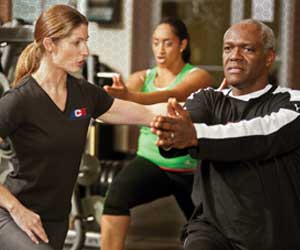You may not be a physical therapist or work at a rehabilitation facility, but chances are you’ll still get plenty of questions from clients about how to help a sore knee or rehab a sprained ankle.

While it’s important to stay within your scope of practice and refer clients to a member of the allied health community when necessary, it’s acceptable to work with clients who have already undergone rehabilitation or those transitioning back to exercise.
Consider those recovering from patellofemoral pain syndrome (PFPS), for example. More commonly known as “runner’s knee,” PFPS is responsible for 16 percent to 25 percent of all running injuries. It can be a frustrating and often painful experience for clients, as it can interfere with everything from training to just getting out of bed in the morning.
It can stop even the most competitive athletes in their tracks. As it should.
Although the cause of runner’s knee can range from overuse to poor mechanics, the same training tactics can be used for most clients.
So how do you tailor an exercise regimen for clients following recovery from PFPS?
The first step is to scale back exercise when knee soreness is present. Avoid aggravating activities like deep squats or running, make sure the client is wearing the right footwear and try using ice.
The second step is to focus a restorative exercise program on three key areas: flexibility, strengthening and functional integration.
Transitioning Back to Functional Movement
Start with closed kinetic chain exercises in the sagittal plane, then progress functional integration by incorporating exercises in the frontal plane, followed by a combination of the two. Start with lower-intensity exercises and gradually progress to more-intense options. The table below lists lower limb exercises with appropriate progressions to improve stability, movement and functional integration.
Using these exercises will keep clients progressing at an intensity level that is suitable for their abilities. Incorporating appropriate exercises and progressions will help restore joint stability and good movement mechanics to the joints of the lower limb, reducing stress on the knee and preventing re-injury.
|
Plane of Motion
|
Exercise Progression (Easy to Hard) |
|
Sagittal Plane
|
Leg press machine → stability ball wall squats → forward lunges → stair walking
|
|
Frontal Plane
|
Side stepping on level surface → side stepping on a step → side stepping with bands
|
|
Combined Planes
|
Multidirectional lunges → single-leg balance with multidirectional toe touch → multidirectional jumps (bilateral)
|
Learn more at our Introduction to Structural Assessment and Corrective Exercise Workshop by Justin Price in San Diego on September 22 and again in Greater Baltimore on December 8. Seating is limited so register today!